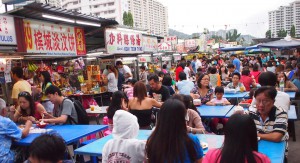Penang property prices affected by signature dishes?
 Found this interesting story by Henry Butcher Malaysia. Read on…
Found this interesting story by Henry Butcher Malaysia. Read on… 
When one mentions Penang, two thoughts usually come to mind: char kway teow (and the island’s assortment of street food), and high property prices. For both, thefocus lies mainly on George
Town, the multicultural capital of the state, which is also home to a Unesco World Heritage Site.
“Penang has a population of about 1.8 million, with an estimated one million in the island proper. Looking at our records, prices are similar to Kuala Lumpur, where it is based on demand.
“On the island, only 54 per cent of our land is suitable and approved for building, while 46 per cent is hill land. So it’s not surprising to see condominiums coming up – there’s no choice.
“What’s interesting is that only five per cent of our transactions are from foreign purchasers; it’s still pretty much a local’s market. Currently, Penang landed properties have a compound annual growth rate of 7.5 per cent; condominiums have five per cent,” according to Henry Butcher Malaysia (Penang) senior vice-president, business strategy and marketing, Max Wong.
Seeing as property prices generally rise when within the vicinity of infrastructure or popular retail or commercial spots, this raises a question: in Penang’s context, does the presence of popular char kway teow stalls (or any other forms of street delicacies) affect property prices in the vicinity?
After speaking to Wong, the short answer is: no.
Long answer: there is one particular instance where it might work out.
Wong’s findings are summarised as such: property prices don’t increase in proximity to popular street food hawkers – they don’t fluctuate that wildly.
According to Wong and data from the team in Penang, “the overcrowded street food stalls like char kway teow and cendol are indeed tourist at tractions in Penang, but looking at property value over the years, the presence of these hawkers in the vicinity does not really help in raising the prices significantly”.
Unlike infrastructure, offices, or shopping malls, street food hawkers have a limited working lifespan, and the eventuality of their retirement makes them unreliable as attraction points when it comes to raising prices.
For example, we take a look at Sister’s Curry Mee in Air Itam, where a pair of aged sisters prepare curry noodles.
“They are retiring soon, and who knows, one day they might find themselves no longer being able to continue the business, and the place they are right now, it’s not helping to raise the property value,” says Wong.
For a more recent example, Siam Road’s char kway teow made its rounds in the media, and the operator took 10 days off, away from the increased attention and popularity. This illustrates the case that the hawker’s presence may not always be consistent enough to be a massive marketing point.
“If the operator isn’t around — recent interviews have him stating his plan to retire — then that’s an issue. Likewise, property prices have not gotten up because of his presence and popularity.”
GOODWILL HUNTING
He further adds, “These kinds of businesses have a deadline – the operators will retire eventually. We won’t deny that we will follow Singapore’s tracks one day, where hawkers will move into a proper centre. Not all the descendants will want to follow their parents’ footsteps either — they want to pursue other undertakings — so they have no choice but to bring in the foreigners. Add to that the prohibition of foreigners being involved in the cooking process, and you have a problem.”
That being said, as mentioned earlier, there is one specific instance where one can get higher prices: coffee shops and hawker centres where the vendors are well-known.
Wong calls this secret ingredient “goodwill” — the increased footfall and customers frequenting the establishment, compared to its neighbours.
“The goodwill of certain places — the price transacted for certain hawker centres — can be higher than comparable available units. For these popular hawker centres, you pay the average property value, plus the goodwill,” he elaborates.
In essence, you pay more, in the knowledge that you gain more in the long term.
“In view of the higher traffic, the price demanded is also higher than usual, because it is generating substantial income for the owners,” Wong says.
Wong looks at three examples that make his case.
“We look at Kheng Pin Cafe, at the junction of Penang Road and Sri Bahari Road. The cafe has been around for ages, and has lobak, char kway teow and chicken rice. It is a leasehold property, and the profit price per sq ft is not high. However, people are willing to pay double the property value because it is a famous place! The owner can then enjoy a higher rental rate, because it is covered, and it can generate higher income.”
The second example is a food court in Bukit Mertajam.
“It registered as having transacted double the average property value. From this, we can say that this is from the goodwill generated from the property itself. However, the surrounding properties in the neighbourhood only registered normal growth, following current trends.”
Thirdly, there is Genting coffee shop in Green Lane — with a stall popular for chee cheong fun.
“It was transacted way above market value because of the goodwill and income generated. The owner demolished and restored the facilities, and increased the rental to RM100 per stall a day — from RM30 previously. So far the hawkers are still smiling despite the increased rental, because it’s crowded!”
Wong further insists, “It has to be coffee shops — hawker stalls by themselves won’t add much value. Lorong Selamat char kway teow is basically a stall — a tricycle stall. It will definitely draw a crowd, but just imagine if the lady decides to close the stall — no crowd, no revenue. So I’m not seeing any jump in property prices.”
So far, it’s good news for these coffee shop owners.
“If you treat this as a core asset to generate income, then it’s good news and good value, unlike pre-war houses,” says Wong.
He adds: “If it’s just a stall or two, it won’t work. Hawker centres and cafes that serve several famous dishes will do well.”
Looking at how hawkers don’t affect property prices, and how coffee shops can bank on goodwill, surely one could generate a win-win scenario by gathering street food hawkers and placing them in a brick-and-mortar shop, no?
According to Wong, that will not work either.
“To people, ordering food from the street is a unique and authentic experience. Penangites don’t frequent roadside stalls that often, but tourists are willing to go to these crowded places. I don’t think ‘upgrading’ them – placing them in physical shops—will do well,” Wong states.
For street food stalls that have physical presence, Wong looks at the famous cendol along Penang Road.
“They have their own shop, but they still maintain the stall because people would rather stand and wait than sit comfortably in the shop. They are the only shop in the row that can generate that much rental.”
Wong further states that the cendol operator’s expansion efforts weren’t successful.
“It has a physical presence in Publika, but it is not doing well, and neither was its branch in Gurney Plaza, and neither was its previous endeavour in Komtar.”
To Wong, the appeal of street food is, in itself, the main point of attraction for tourists, which cannot be captured and retained.
“You see, they cannot move their unique character, and people are willing to queue for the cendol, but they lose interest and appeal when you get them to sit in a shop. Based on this and our observation, moving these street hawkers into a physical shop is a no-no. You
change that character, they become common.
We’ve seen some steamboat businesses try their hand at expansion, and it wasn’t fruitful — it has to be that particular spot.”
Aside from that, most of these hawkers are located within the designated Unesco Heritage Site, and there are very little new projects in this area — developers are not allowed to build anything higher than five storeys.
From Wong’s data, “all the properties around these stalls are just shophouses, they start at RM1,000 per sq ft and can go up to RM2,000 per sq ft, and there are hardly any listings because a lot of the owners are holding”.
With ageing street food sellers, a generation reluctant to take up the family business, and a lack of local talent willing to pick up the tricks of the trade, Penang’s street food scene is soon to undergo a period of change.
That being said, existing owners can rest assured that property prices around these spots will not rise and fall on the existence of these individuals.
Whether that’s good news or otherwise, that’s on you, the beholder.
Story courtesy of Henry Butcher Malaysia
Source: New Straits Times

